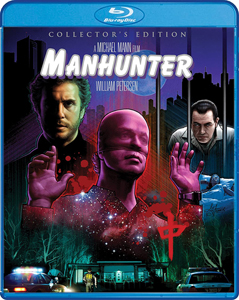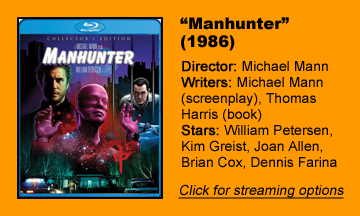To mark the 40th anniversary of author Thomas Harris’ invention of Hannibal Lecter and the 30th anniversary of “The Silence of the Lambs” – the only horror film to win Best Picture – we’re looking back at the four books and five films of the Hannibal Lecter series over nine Frightening Fridays. Next up is the first film, “Manhunter” (1986):
Introducing Hannibal Lecktor
By giving itself a new name, “Manhunter” seemingly shies away from Harris’ “Red Dragon” (1981), but it’s actually a faithful adaptation. Except for the final showdown, every scene – if not word-for-word identical – serves the same purpose as in the book.
This is remarkable because Harris’ book has the unusual structure wherein Will Graham (William Petersen) deals with the imprisoned Hannibal Lecktor (the film changes the spelling for some reason) (Brian Cox) in the first half, and villain Francis Dollarhyde (the film adds an extra L) (Tom Noonan) and his blind girlfriend Reba (Joan Allen) are introduced in the back half.
But writer-director Michael Mann, in adapting a novel into a 2-hour movie, inevitably leaves holes (otherwise it’d be a robust miniseries). The two biggest holes are the lack of backstory for Dollarhyde and the downplaying of horror elements.
I’d recommend “Manhunter” as an enjoyable film before I’d recommend it to someone strictly seeking scares.
Drenched with style
Its two biggest appeals are Petersen and the style. Neon lights, quiet and dark skyscraper-laden cities, a synthesizer score, pop love songs, rain, short shorts on guys, big curly hair on women … this is tasty Eighties noir.
Accidentally, I burned a bag of popcorn before watching the film, and it added that smoke smell to go with the perpetual cigarettes, so I had the full sensory experience. (Unfortunately, the smell lasts longer than a film’s runtime, so I don’t recommend doing it on purpose.)
Petersen grew on me as the soft-spoken Graham, whose passion for catching Dollarhyde is largely internal. Mann uses Graham as the through-line. Sensual turquoise-lit scenes with his wife Molly (Kim Greist) and a grocery-aisle chat with his son Kevin (David Seaman) about Will’s psychological troubles underscore the theme: Graham is trying to push the Hannibals and Dollarhydes out of his life – by caging them, not killing them – so he can enjoy a normal family life.
Dollarhyde looks like a generic awkward creep, and Noonan is hamstrung by the lack of a sympathetic backstory that makes the book so rich. Also, his “In Cold Blood”-style wholesale slaughters of families are presented tamely enough that by the 21st century such images would appear in network procedurals such as Petersen’s “CSI.”
Allen is unconvincing as a blind woman, and has no chemistry with Noonan, so that’s another strength of the book that’s missing.
Helps to read the book
I’m glad I read the book first, because “Manhunter’s” insistence on leaving out the most horrific elements makes things confusing. Someone without the book’s grounding might not realize that reporter Freddy Lounds (Stephen Lang, “Avatar”) has his lip bitten off by Dollarhyde, is glued to a wheelchair and set afire, and then briefly survives in a burned state.
The movie blasts through a lot of the procedures, too, which is admittedly appropriate as investigators are racing against the next full moon and don’t even know what city the perpetrator is in. Will and his FBI boss, Jack Crawford (Dennis Farina), often literally run through hallways to try to solve this case faster.
When the film slows enough to be graspable, the procedures are a wonderful slice of limited 1986 technology, including the verbal relay of information via telephone. The use of a fax machine on a plane probably struck viewers at the time as remarkably cutting-edge.
I realize I’ve gone through this review barely mentioning Hannibal – but again, that matches with the novel, where Hannibal barely appears. Cox projects a cultured air more so than hidden menace, whereas the Hannibal actor I’m most familiar with, TV’s Mads Mikkelsen, simultaneously projects both. Given more scenes, Cox perhaps could’ve been a menacing Hannibal, but we don’t see signs of this in “Manhunter” itself.
“Manhunter” is ultimately missing a lot of the edge of Harris’ book, but its softer approach – driven by Petersen’s subtly good turn – has its own appeal. It’s more of-its-time than it is timeless (which is perhaps why it was later remade as “Red Dragon”), but 1986 neon noir isn’t a bad place to time-hop back to.



